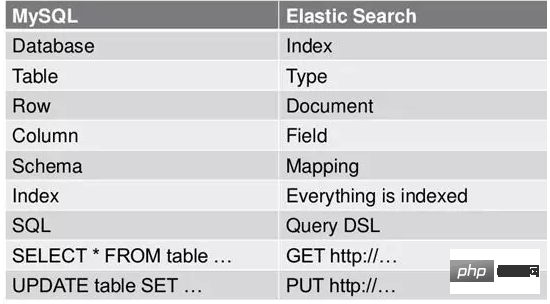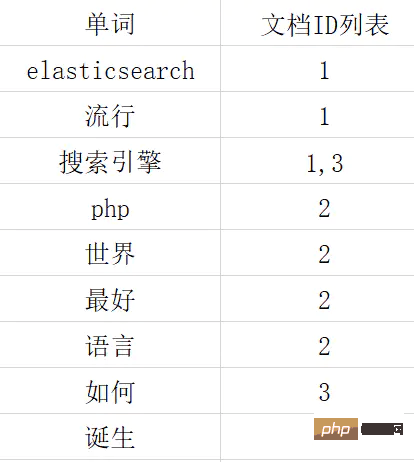About the correct posture of using es in laravel
The following tutorial column of Laravel will introduce you to the correct posture of using es in laravel. I hope it will be helpful to friends in need!

##Elasticsearch Introduction
The bottom layer of Elastic is the open source libraryCourse Recommendation→: "Elasticsearch Full Text Search Practical Combat" (Practical Video)
From the course"Ten Million Level Data Concurrency Solution (Theoretical Practical)》
ES and Mysql
The concepts in ES are analogous to Mysql as follows As shown in the picture:
Inverted index
Before talking about inverted index, let’s first talk about what is forward index index. Forward index is also called "forward index", which is the basis for creating inverted index. As above, when querying which documents a keyword is contained in, all documents need to be scanned to ensure that there are no omissions. This will greatly extend the retrieval time and reduce the retrieval efficiency. At this time we used the inverted index, first segmenting the document into words.
As above, when querying which documents a keyword is contained in, all documents need to be scanned to ensure that there are no omissions. This will greatly extend the retrieval time and reduce the retrieval efficiency. At this time we used the inverted index, first segmenting the document into words.  For example, we want to query in which documents the keyword 'search engine' appears. First, we can use the inverted index to query the document positions where the keyword appears in 1 and 3; then we can query the contents of documents 1 and 3 through the forward index and return the results.
For example, we want to query in which documents the keyword 'search engine' appears. First, we can use the inverted index to query the document positions where the keyword appears in 1 and 3; then we can query the contents of documents 1 and 3 through the forward index and return the results.
Laravel uses ES
Installing plugins
basemkhirat/elasticsearch is an extension for using ES in Laravel. It is very convenient to use: 1) Installation method
$ composer require basemkhirat/elasticsearch2) Publish
$ php artisan vendor:publish –provider=”Basemkhirat\Elasticsearch\ElasticsearchServiceProvider”
configuration
In this way we have installed it. The following is our connection configuration:'connections' => [
'default' => [
'servers' => [
[
"host" => env("ELASTIC_HOST", "127.0.0.1"),
"port" => env("ELASTIC_PORT", 9200),
'user' => env('ELASTIC_USER', ''),
'pass' => env('ELASTIC_PASS', ''),
'scheme' => env('ELASTIC_SCHEME', 'http'),
]
],
'index' => env('ELASTIC_INDEX', 'my_index')
]],Usage method
The usage method of this plug-in can be used for reference from Laravel’s query constructor, which supports commonly used ones such aswhere , whereIn, whereBetween, orderBy, first, get, also supports the paging method paginate.
$documents = ES::connection(“default”)Set field weight:->index(“my_index”)
->type(“my_type”)
;get(); # return a collection of results
ES::type(“my_type”)->search(“hello” , function($search){We can also modify the source code to expand the methods we need, or we can construct native query statements:$search->boost(2)->fields([“title” => 2, “content” => 1])
})-> get();
$params['body'] = [ 'aggs' => [ 'all_created' => [ 'terms' => [ 'field' => 'element.raw', 'size' => $this->_mAggsPageSize ], 'aggs' => [ 'sum_pv' => [ 'sum' => ['field' => 'pv'], ], ], ], ], ];
Conclusion
ES built-in tokenizer is not friendly to middle splitting support. The more recommended one is IK tokenizer. It should be noted that the ik version needs to be consistent with the ES version number.
The above is the detailed content of About the correct posture of using es in laravel. For more information, please follow other related articles on the PHP Chinese website!

Hot AI Tools

Undresser.AI Undress
AI-powered app for creating realistic nude photos

AI Clothes Remover
Online AI tool for removing clothes from photos.

Undress AI Tool
Undress images for free

Clothoff.io
AI clothes remover

Video Face Swap
Swap faces in any video effortlessly with our completely free AI face swap tool!

Hot Article

Hot Tools

Notepad++7.3.1
Easy-to-use and free code editor

SublimeText3 Chinese version
Chinese version, very easy to use

Zend Studio 13.0.1
Powerful PHP integrated development environment

Dreamweaver CS6
Visual web development tools

SublimeText3 Mac version
God-level code editing software (SublimeText3)

Hot Topics
 1663
1663
 14
14
 1420
1420
 52
52
 1313
1313
 25
25
 1266
1266
 29
29
 1239
1239
 24
24
 Laravel Introduction Example
Apr 18, 2025 pm 12:45 PM
Laravel Introduction Example
Apr 18, 2025 pm 12:45 PM
Laravel is a PHP framework for easy building of web applications. It provides a range of powerful features including: Installation: Install the Laravel CLI globally with Composer and create applications in the project directory. Routing: Define the relationship between the URL and the handler in routes/web.php. View: Create a view in resources/views to render the application's interface. Database Integration: Provides out-of-the-box integration with databases such as MySQL and uses migration to create and modify tables. Model and Controller: The model represents the database entity and the controller processes HTTP requests.
 Solve caching issues in Craft CMS: Using wiejeben/craft-laravel-mix plug-in
Apr 18, 2025 am 09:24 AM
Solve caching issues in Craft CMS: Using wiejeben/craft-laravel-mix plug-in
Apr 18, 2025 am 09:24 AM
When developing websites using CraftCMS, you often encounter resource file caching problems, especially when you frequently update CSS and JavaScript files, old versions of files may still be cached by the browser, causing users to not see the latest changes in time. This problem not only affects the user experience, but also increases the difficulty of development and debugging. Recently, I encountered similar troubles in my project, and after some exploration, I found the plugin wiejeben/craft-laravel-mix, which perfectly solved my caching problem.
 Laravel user login function
Apr 18, 2025 pm 12:48 PM
Laravel user login function
Apr 18, 2025 pm 12:48 PM
Laravel provides a comprehensive Auth framework for implementing user login functions, including: Defining user models (Eloquent model), creating login forms (Blade template engine), writing login controllers (inheriting Auth\LoginController), verifying login requests (Auth::attempt) Redirecting after login is successful (redirect) considering security factors: hash passwords, anti-CSRF protection, rate limiting and security headers. In addition, the Auth framework also provides functions such as resetting passwords, registering and verifying emails. For details, please refer to the Laravel documentation: https://laravel.com/doc
 Laravel framework installation method
Apr 18, 2025 pm 12:54 PM
Laravel framework installation method
Apr 18, 2025 pm 12:54 PM
Article summary: This article provides detailed step-by-step instructions to guide readers on how to easily install the Laravel framework. Laravel is a powerful PHP framework that speeds up the development process of web applications. This tutorial covers the installation process from system requirements to configuring databases and setting up routing. By following these steps, readers can quickly and efficiently lay a solid foundation for their Laravel project.
 Laravel and the Backend: Powering Web Application Logic
Apr 11, 2025 am 11:29 AM
Laravel and the Backend: Powering Web Application Logic
Apr 11, 2025 am 11:29 AM
How does Laravel play a role in backend logic? It simplifies and enhances backend development through routing systems, EloquentORM, authentication and authorization, event and listeners, and performance optimization. 1. The routing system allows the definition of URL structure and request processing logic. 2.EloquentORM simplifies database interaction. 3. The authentication and authorization system is convenient for user management. 4. The event and listener implement loosely coupled code structure. 5. Performance optimization improves application efficiency through caching and queueing.
 How to learn Laravel How to learn Laravel for free
Apr 18, 2025 pm 12:51 PM
How to learn Laravel How to learn Laravel for free
Apr 18, 2025 pm 12:51 PM
Want to learn the Laravel framework, but suffer from no resources or economic pressure? This article provides you with free learning of Laravel, teaching you how to use resources such as online platforms, documents and community forums to lay a solid foundation for your PHP development journey from getting started to master.
 How to view the version number of laravel? How to view the version number of laravel
Apr 18, 2025 pm 01:00 PM
How to view the version number of laravel? How to view the version number of laravel
Apr 18, 2025 pm 01:00 PM
The Laravel framework has built-in methods to easily view its version number to meet the different needs of developers. This article will explore these methods, including using the Composer command line tool, accessing .env files, or obtaining version information through PHP code. These methods are essential for maintaining and managing versioning of Laravel applications.
 What versions of laravel are there? How to choose the version of laravel for beginners
Apr 18, 2025 pm 01:03 PM
What versions of laravel are there? How to choose the version of laravel for beginners
Apr 18, 2025 pm 01:03 PM
In the Laravel framework version selection guide for beginners, this article dives into the version differences of Laravel, designed to assist beginners in making informed choices among many versions. We will focus on the key features of each release, compare their pros and cons, and provide useful advice to help beginners choose the most suitable version of Laravel based on their skill level and project requirements. For beginners, choosing a suitable version of Laravel is crucial because it can significantly impact their learning curve and overall development experience.




